

Table of contents
- Typical companion plants in the heather garden
- dwarf conifers
- shrubs
- grasses
A heath garden impresses with a superficially simple, almost sparse appearing vegetation. Over time, however, the viewer becomes aware of a wealth of different plants, which give this garden a constantly new character. This type of garden can be easily realized with a planting plan that coordinates all accompanying plants. Our overview explains which species can also be used to turn your front yard into your very own heathland.
Typical companion plants in the heather garden
The main vegetation on heathland is mostly dominated by two plant genera: Calluna and Erica. Both genera have innumerable species and forms, so that an enormous variety arises from this overgrowth. But it is the accompanying plants that actually make this form of vegetation what it is. Here is a much larger range of different genera to choose from for your planting plan:
dwarf conifers
The dwarf forms of native conifers are particularly suitable for your own heathland in the front yard. Due to the comparatively large dimension despite the dwarf form, these types of garden design give a third dimension. On the other hand, the low, squat core characteristic of the heath is replaced by the nonetheless remaining low Growth forms not changed significantly, just complemented and in an interesting way loosened up.
juniper(Juniperus communis)
- Growth height up to a maximum of 3 meters, dwarf forms usually significantly lower
- Growth habit Crouching low, or columnar upright
- Strong, clearly defined spines
- Inconspicuous yellow flowers, later deep dark blue to red berries
- High light requirement, therefore often found in low-growing heathland without other trees
- Considered undemanding, therefore suitable for poor limestone and sandy soils
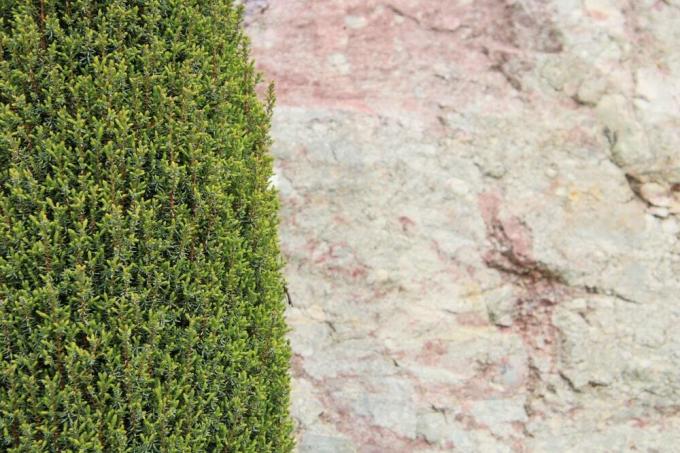
A NOTICE:
In the typical poetry of Romanticism, juniper as a typical vegetation of the Central and North German juniper heaths is found again and again as a central element of the mood-giving frame. Themes such as the shepherd, who is close to nature and leads his flock through the ever-changing juniper heath in harmony with the seasons, are popular.
Pine trees(pinus)
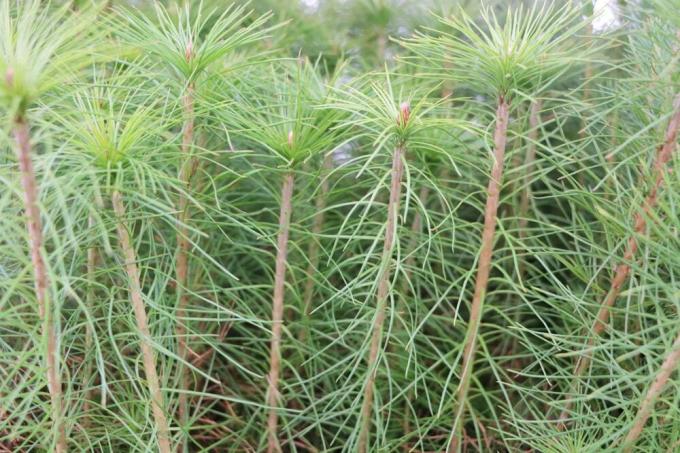
- e.g. B. as dwarf pine, shrub pine or mountain pine
- long needles on all sides of the shoot
- Umbel-like, rather inconspicuous yellow-green (male) or red (female) inflorescences
- with low stature usually squat, bushy growth habit
- very high resin content, therefore often with a typical, intense resin smell
- is considered frugal, so it can be easily combined with typical heathland soils
- easy to adjust in shape and size by cutting
spruces(Picea)

- evergreen
- characteristic scaly, red-brown bark
- bushy growth only in the right location: open, windy, little sheltered, barren, sandy soil with low nutrient content
- short opposite needles with bushy shoot ends
- Cones singly or in pairs at the tips of the shoots
- Inconspicuous, yellowish flower
- Typical conifer scent due to high resin content in wood, bark and shoots
Hemlock(Tsuga)
- as a cushion hemlock, often flat, little growing
- short, strongly protruding needles arranged on all sides
- very inconspicuous greenish flowers
- tiny cones mostly under 1 centimeter
- good options for shaping, but required to a much lesser extent than e.g. B. at pines
A NOTICE:
The hemlock is not a typical overgrowth found in natural heathland. Due to its properties and in particular its low growth forms, it is a good companion plant for your own heath design. It is therefore representative of various cultivated forms of coniferous trees, which were bred to grow slowly and remain small, especially for the limited space available in domestic gardens.
shrubs
In addition to conifers that remain small or are deliberately kept small, there are various types of shrubs that can also be used to visually enrich your heathland with a little abundance and height. In contrast to most coniferous trees, shrubs are also able to add further, clearly recognizable facets to the floral splendor.
broom(Genista)
- Growth habit bushy compact to upright and lush
- Plant heights between 0.5 and 2.0 meters, in individual cases even higher
- dense, flat leaves, vaguely reminiscent of typical coniferous growth
- Intense yellow flowers with small flowers, but large number of flowers at the end of the shoots
- depending on the species with reinforced shoots

DANGER:
All parts of the gorse plant are considered poisonous, so that heather plantings, especially in gardens with children or pets, should use gorse with appropriate caution.
crowberry(Empire)
- evergreen dwarf shrub with a height of 15 to 60 centimeters
- needle-shaped leaves with a dense stand
- Inflorescences: one to a maximum of three small, inconspicuous flowers
- As a variant with black (G. negrum) or red (G. rubrum) berries available
- Berries are edible, but other parts of the plant contain andromedotoxin - slightly toxic
- Very dominant appearance, sometimes crowding out other heather plants
TIP:
If you want to use the crowberry as a companion plant despite its dominant spread, you can use the plant either place them in a separate pot, or use a root barrier to ensure unhindered growth prevent.
cranberry(Vaccinium macrocarpon)
- Closely related to the blueberry
- Small alternate leaves of roundish-oval shape
- Opposite, clustered flowers of pale pink hue
- Red edible fruits with a sweet and sour, sometimes bland taste
- prefers moors, heaths and light forest soils
- often known under the English name "Cranberry".
rhododendron(Rhododendron)
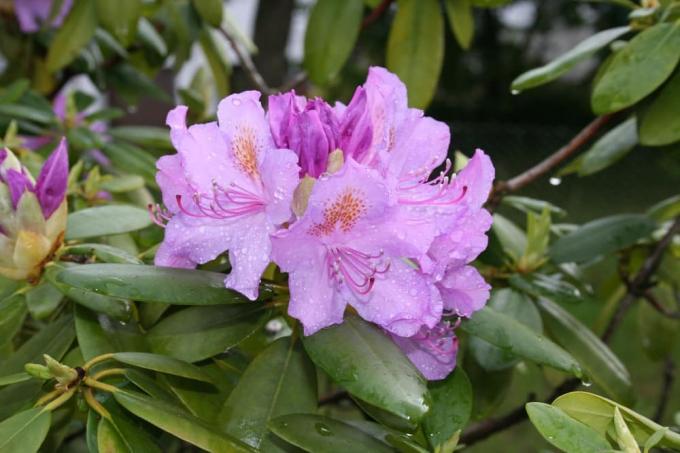
- Widespread species family with over 1,000 species
- Growth height dwarf rhododendron approx. 50 to 80 centimeters
- Magnificent, large-sized calyx flowers
- Various flower colors from white to shades of yellow to red and reddish brown
- Large, long-oval leaves with a dark green, mostly waxy surface
- particularly good on slightly acidic soils, e.g. B. settle peat soils
- Archetypes partly strongly scented (also leaves)
- Characteristic color of the new shoots coppery to bluish (depending on the species)
grasses
Finally, ornamental grasses offer a good opportunity to selectively loosen up the comparatively uniform level and appearance of the heather planting. Grasses can contrast the generally rather bushy, flat growth form of heather plants with a striking but not dominant counterpart.
sweet grasses(Poaceae)
- Extremely species-rich plant family with over 12,000 species
- Very wide distribution area with adaptations to different locations and climatic conditions
- Both annual and hardy available
- Growth heights of around 30 centimeters to more than one meter are possible for variants suitable for heathland
- Mostly upright growing with long straight culms
- Best-known representative: bamboo (due to its dominant appearance but less suitable for moor gardens)
sedges(Cyperaceae)
- High biodiversity up to
- Very perennial plants
- Prefer moist to wet soil
- periwinkle
- Most common genus: Carex
- Mostly distinctive infructescence as a more or less compact panicle or spike
rushes(Juncaceae)
- Small family me only around 400 species
- Less conspicuous appearance than sweet grasses or sedges
- Height of growth around 1.00 to 1.50 meters
- Mostly very upright growth without distinctive infructescence
- Prefers temperate to cool climates
- Prefers moist locations, therefore e.g. B. can be used for bog heath
- Found in the home garden mainly as bulrush (Juncus) or marble (Luzula).
Cattail family(Typhaceae)
- The only genus Typha with only around 10 species
- Require fresh water, therefore can only be used in combination with a heath garden and a pond
- Very keen to grow
- Distinctive infructescence as clearly recognizable pistils at the end of the stable, mostly tube-like, thickened culm
- Growth heights up to 2 meters, so only choose low-growing species
Tip:
Don't forget to include other appropriate elements in your heather planning alongside companion plants. Both solitary stones and dead wood such as roots can loosen up and enrich the design.
 garden editorial
garden editorial I write about everything that interests me in my garden.
Learn more about ornamental grasses
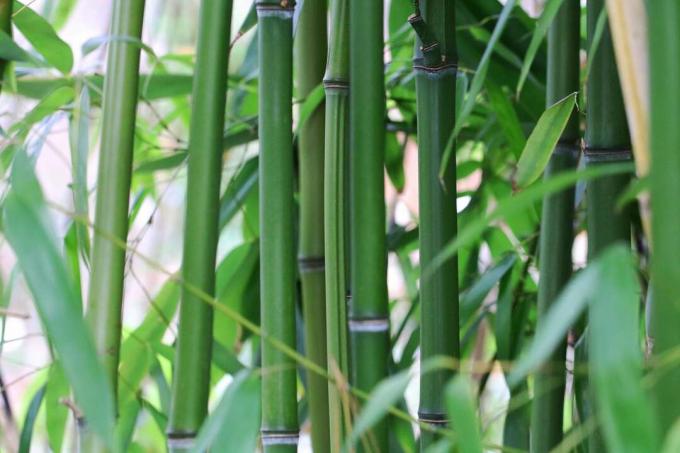
cutting bamboo | When and how to cut back bamboo?
Be it as a hedge, solitaire or ground cover, bamboo can be seen more and more often in home gardens. Because the sweet grass is easy to care for and easy to grow. However, the latter can quickly become a problem if the plants are not pruned regularly.

11 Tips for Cutting Grasses | Tools & Co.
Cutting ornamental grass works best with our tips: From choosing the right tool to right time - we have the most useful tips and tricks for you for the annual grass cut summarized.
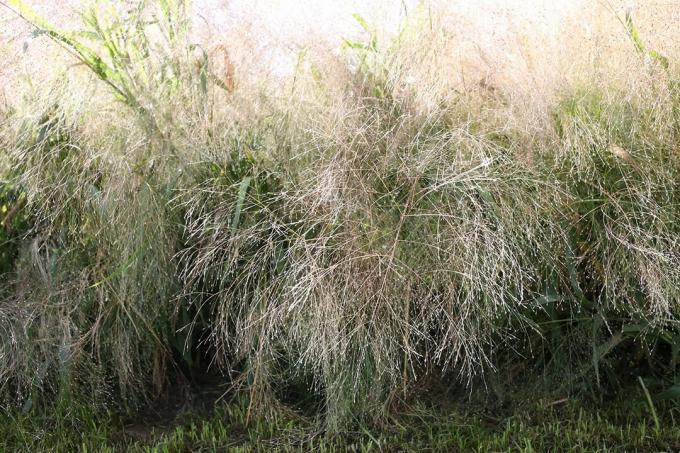
Switchgrass, Panicum virgatum: Care from A – Z
Switchgrass is an upright-growing, clump-forming grass with narrow leaves. The species is considered to be easy to care for and makes few demands on location and soil. Read how to optimally plant and care for Panicum virgatum.

Zebra grass, Miscanthus sinensis 'Strictus': care from A - Z
In botanical jargon, zebra grass is also called Miscanthus sinensis 'Strictus'. The plants can be used wonderfully as privacy screens and are decorative. From care in the tub to overwintering: You can find information on care from A - Z here.

Grow pampas grass from seeds: we explain how
Pampas grass is considered easy to cultivate and can be successfully propagated by breeding. Under controlled conditions in the planter, the germination success is higher than with direct outdoor sowing. The procedures regarding substrate, choice of location and care hardly differ in these variants.
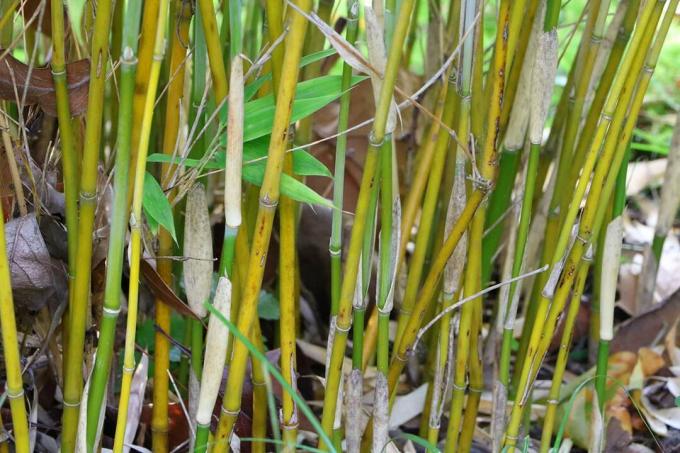
Grasses as a privacy screen: 20 tall grasses
Numerous grasses are ideal as privacy screens! We present the 20 most popular grasses in this article!


